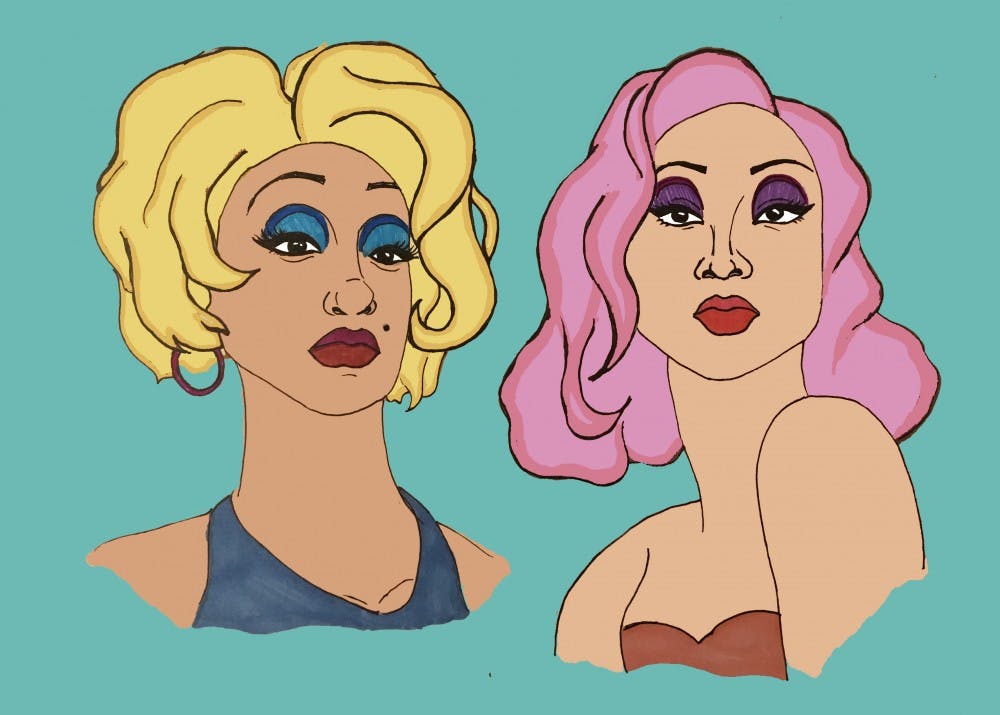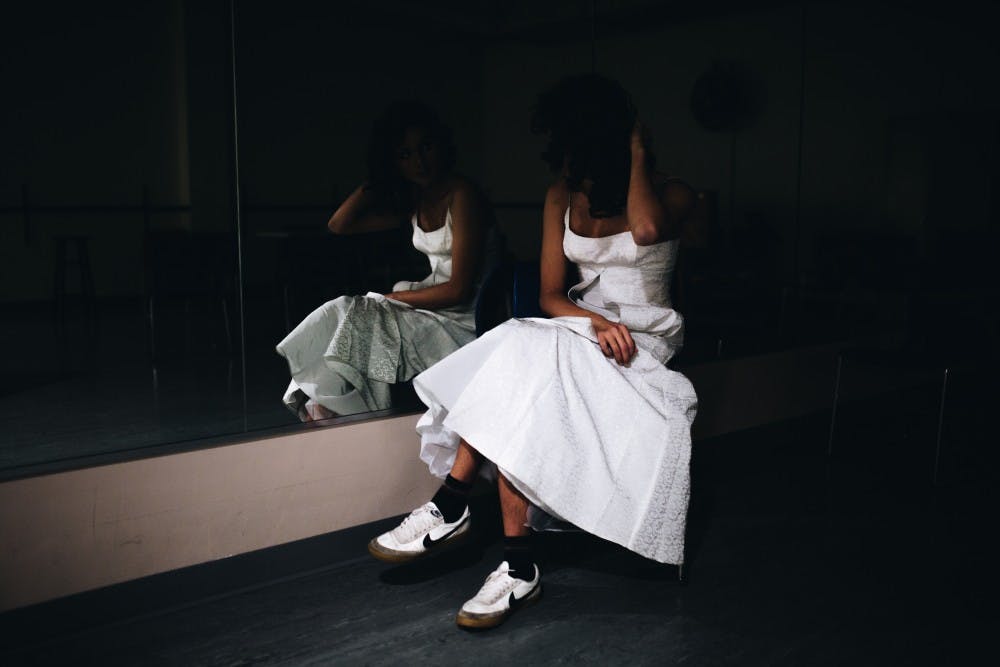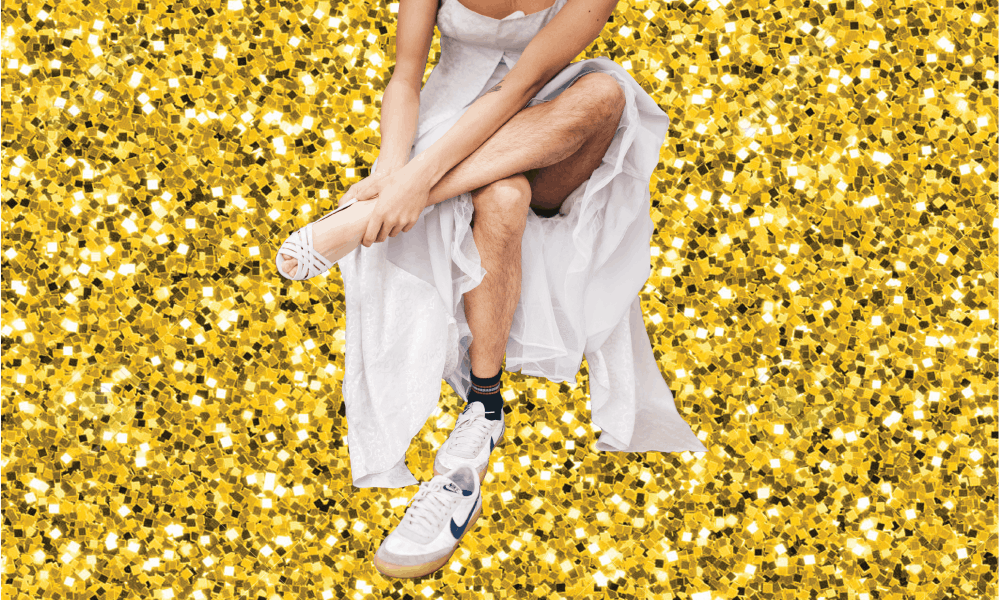A towering figure in a full–length, tan fur coat and white go–go boots saunters on stage. Peering at the crowd through strands of his blonde wig, John Holmes (C ‘18) lip syncs to a number from the musical Chicago. He slowly spins around on stage and mimes the lyrics of the song to periodic shrieks of encouragement, exaggerating his every movement with drama and panache. As he luxuriates on a chair on stage with the tatters and rips in his fur coat fully visible, the recorded voice of Catherine Zeta–Jones wails, “Whatever happened to class?”
The rest of the show follows. An oversized belt cinches a stark white jumpsuit. Teased–out blonde wigs with dark roots are poofed up as frizzy as possible. Bodycon dresses and six–inch platform heels go emulate femininity—to a caricature at points.
Queens perform pop hits, sashaying across the stage while hitting splits and death drops during the crescendos. Screams and cheers follow each performer—there are over a hundred people in the room, but feels like a gathering of friends.
This is the Penn Drag Show, an event hosted every year by the Penn Queer Student Alliance (QSA) where a few queens dress up and lip sync to a boisterous crowd of friends.
The most recent show took place on March 23, closing out QPenn Week, Penn’s annual LGBTQ cultural week on campus. This is where Penn’s rarely–visible drag community comes together as a whole—both fans and participants. Some may only dress up for Penn’s drag show, some perform local gigs in Philadelphia, and others dress in drag to go out at Penn. However, for all of these students, drag is a way to play with the concept of gender and explore their own identities in a way that Penn’s professional atmosphere does not allow for.
John, one of the two hosts of the Penn Drag Show, has been involved with the show for the past two years. However, those who’ve been to the show might know him better as D’Genni Raight, his drag persona playing on the word ‘degenerate.’ John acknowledges that encouragement from his friends and the low–stakes, friendly atmosphere of the show made it much less daunting to put on a wig and perform in drag for the first time.
“It’s kind of ‘come as you are’—there’s no one way to do drag,” John said. “Whatever you decide to go up on stage and do, people are going to cheer for you.”

Contemporary drag has its roots in New York City ball culture. In post–Stonewall NYC, queer individuals would group into “houses” and compete in categories such as vogueing and “realness” (looking as traditionally feminine as possible). The first queens were often gay or transgender people of color, and their influence hasn’t left the drag stage. In particular, contemporary drag has been popularized by the reality competition RuPaul’s Drag Race, which has allowed drag to enter the mainstream since its 2009 premiere. Drag Race, now in its tenth season, took home three Emmys last year and has featured guest stars as prolific as Nancy Pelosi and Lady Gaga. Beyond its impressive ratings, the show has popularized various phrases and traditions that date back the ball scene over four decades ago. The undeniable entertainment of the show has particularly drawn in younger queer people, giving them a chance to learn about their own history.
Jessa Lingel, an Assistant Professor at the Annenberg School, has studied Brooklyn drag queens, among other countercultural groups. She points out that drag has a way of connecting younger people to queer history, which is rarely given mainstream attention or taught in school curriculums. She describes contemporary drag as, “a desire to retain queerness as something directly opposed to the ‘normal.’”
In this way, drag at Penn allows students to express their creative sides that don’t fit into a preprofessional blazer.
Lingel agrees. “It would make a lot of sense for students to want to use drag as a way of managing the uptightness at Penn and the professionalism at Penn and the normative push towards upper class lifestyles.”
Despite enthusiasm for the yearly drag show, however, there is scarcely a regular “drag scene” here on campus. Individuals looking for broader exposure to drag must instead venture downtown into the vibrant Philadelphia drag scene. From drag club meccas like ICandy (a club at which the owner was recently recorded using the n–word) and Voyeur to rowdy bars like Bob and Barbara’s, Philly houses one of the most diverse drag communities in the country. These venues feature drag legends and ingenues—oftentimes new queens that were encouraged by fellow queens to pick up a wig.
Josef Hoenzsch (E ‘17), who uses they/them pronouns, is one of the few Penn students to make a name for themselves as a queen. Under the name “Annie De Beers,” Josef gradually became a “medium–sized fish in a huge pond” of the Philadelphia drag scene. One night, the host of the weekly show at Bob and Barbara’s, NYC icon Lisa Lisa, picked Josef out of the crowd and asked them to perform. Josef began their drag career by emulating Kesha. In their first performance, they lip synced to “Blow” while wearing a black off–the–shoulder dress, six–and–a–half inch heels, and a bra stuffed with socks.
“I was very into trashy drag,” they explain.

Josef Hoenzsch (E ‘17) dragged out as Annie De De Beers.
Photo provided by Josef.
After this performance, Josef began networking with other bars and drag queens. Amidst pursuing a Bachelor’s and Master's degree in Engineering, they performed up to six or seven times a month. Josef cites times when they would get out of class just one hour before they had to be on stage. “I learned to beat a face in under 20 minutes.” (Ed. note: to “beat a face” means to do one’s makeup; no physical harm involved.)
Beyond Philly drag shows downtown, there are other ways to take part in drag at Penn apart from the annual show. John describes occasionally dressing up for social events in varying degrees of makeup, women’s clothing, and wigs, something he feels more comfortable doing after having performed at the drag show.
Josef used drag to explore their own relationship with gender. Drag encouraged Josef to continue presenting in a way that felt true to their own gender identity even when they were offstage.
“This wasn’t something that was just restricted to when I was performing,” Josef said. “It became this thing where I was like … I’m gonna wear my six–and–a–half inch heels strutting down Locust Walk with hair down to my ass and gorgeous fishnets.”

While drag can be a exploration of gender identity for some, it can solely be a fun hobby for others. This is the case for Tyler Dullinger (W ‘20) and Jason Knies (C ‘20), two friends who were drawn to dressing up in women’s clothing as kids, but decided to officially drag themselves up after becoming hardcore fans of RuPaul’s Drag Race. They both performed in this past drag show by lip syncing to “M.I.L.F. $” by Fergie in tight bandage dresses and platforms. The crowd exploded into a frenzy of applause and yells as the queens peppered the infectious pop beat with countless suggestive dance moves.
Both Tyler and Jason use drag to access a more confident, glamorous side of themselves. Tyler made his first foray into drag in high school, where he dressed up for Halloween as Britney Spears from her ...Baby One More Time music video. “It was a sickening look,” he adds. (Ed. note: “sickening” is a good thing.)
Coming from a “pretty conservative” boarding school, Tyler explains that he dressed up in drag that Halloween for shock value as a way to completely subvert traditional norms.
Jason also found his drag roots in imitating celebrities, dressing up as Kesha, whom he was “obsessed” with, when he was nine.
“I wore a wife beater that I used a sharpie to put the Kesha dollar sign on … and then I think I wore jean shorts that I borrowed from my sister, fishnet leggings … there was no makeup, though—maybe lipstick, but that was it.”
With their coiffed blonde hair, nipped–in waists, and shimmering bedazzled bodysuits, female pop stars are the starting point for many fledgling drag queens. What starts out as a mere costume emulating a certain celebrity can soon grow into a fully fleshed–out, individualized drag persona.
“I just find females to be so glamorous … I always found it very alluring,” Jason explains.
Both Jason and Tyler have since dressed up to attend Drag–Con, a drag convention organized by RuPaul. Drag Race encourages them to dress up in drag to emulate their favorite queens from the show. Both of them performed for the first time in Penn’s drag show, and express interest in doing more in the future. Drag imbues them with a certain confidence that they don’t find anywhere else.
Tyler has also experimented with drag off–stage. “I’ve gone to McDonald’s in a wig and heels before and had the cashier be like ‘did you lose a dare?’ and I’m like ‘no, this is just me being sickening getting my McNuggets.”
Jason explains that drag brings out a more outgoing version of himself. “I don’t feel like a different person. I just feel like an amplified version of myself,” Jason says. “Everything I’m doing is very extra, a lot of confidence where I probably shouldn’t have any because I look busted.”
Tyler chimes in, “There’s a magic that happens when you put on a pair of heels.”
Theater can complicate the definition of drag on campus. As an all–male musical comedy troupe, the Mask and Wig Club often features men dressed as women in their sketches or musical numbers, raising of the question of what qualifies as “drag.”
Chairman Zeeshan Mallick (C ‘18) wouldn’t categorize the performances as “drag shows,” maintaining that the group’s use of drag is more a theatrical tool than a vehicle for self–expression.
This introduces the fine line between drag and simply wearing traditionally feminine clothing. Is it “drag” if a cisgender heterosexual man puts on a dress to perform a scene? Some would argue that “true” drag requires some sort of intention beyond solely dressing up. For some, drag is meant to be a caricature that comments on gender roles through subversion. While Mask and Wig’s productions are not meant to be conventional “drag” shows, individual performers can embrace the act of dressing up as “drag,” while others view it as solely wearing a costume.
“There are cast members that really know how to do their makeup and know how to pad themselves … it’s kind of individualized,” Zeeshan adds.
While drag may appear to be liberating, tensions in the queer community exist regarding the inevitable transphobia drag produces. Some members of the queer community, even drag icon RuPaul himself, have been accused of exhibiting transphobia within the world of drag. Josef brings up the insensitive remarks that trans individuals often receive in queer spaces. “Many of my trans friends do not step foot in ‘gay bars.’ If you are a trans woman...you’re treated like a drag queen,” they explain.
With these issues, it’s apparent that the drag scene may not be welcoming for everyone. When cisgender gay men break out a leotard and a blonde wig and lip sync on stage, they are lauded for being bold, fierce, and breaking norms. However, when transgender or gender nonconforming individuals dress up the same way, they are often bombarded with prejudiced judgements, even within the progressive ‘haven’ of a gay bar. Josef attests to being called transphobic slurs at bars, and emphasizes that this behavior is far from an anomaly—it’s almost the norm.
On the other side of the coin, drag can also be criticized for promoting what some would call a mockery of femininity, or a willingness to indulge in sexist stereotypes. Drag queens often cherry–pick the elements of femininity they deem desirable, which can enforce the idea that the ideal “woman” should possess certain qualities.
Lingel expresses occasional frustration with drag’s enforcement of gendered stereotypes after having attended various drag shows as a part of her studies. “Sometimes it does get really tedious to see femininity portrayed this way [at drag shows] … like, why do you have to portray us as sluts or dumb or as super [materialistic]?” she asks. “You’re playing into some of the worst parts of patriarchy when you do that kind of essentialism.”
Like all subversive social movements, drag can be occasionally misguided. From its inherent politicization to its tattered wigs and messy jump–splits, drag will always be a rough–around–the–edges act of self–expression that stands in opposition to what has been considered “normal” in society for hundreds of years.
Through all this, Josef maintains that drag was invaluable to their personal growth, arguing that it encompasses all forms of self–expression: masculinity, femininity, neither, both, trashiness, glamour. They laugh, “It’s also nice to go to a bar, not pay cover, get free drinks, and leave with more money than you came with. Not many people get to say that.”
Dalton DeStefano is a sophomore studying Communication from Montville, New Jersey. He is the Developing Features Editor for 34th Street.

